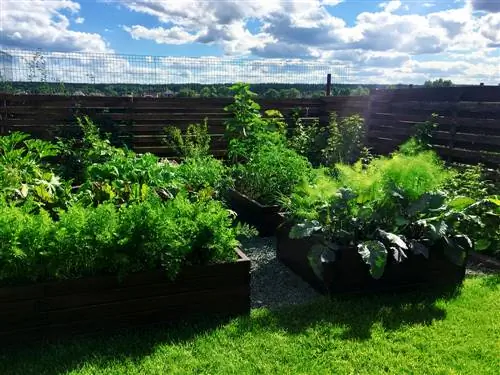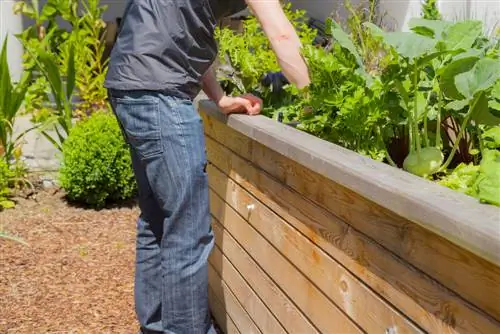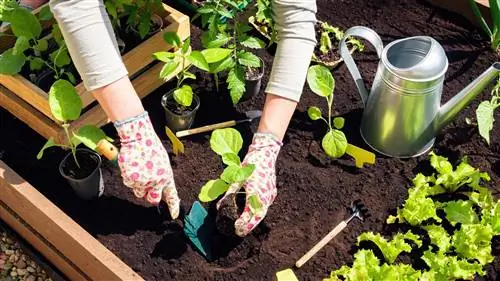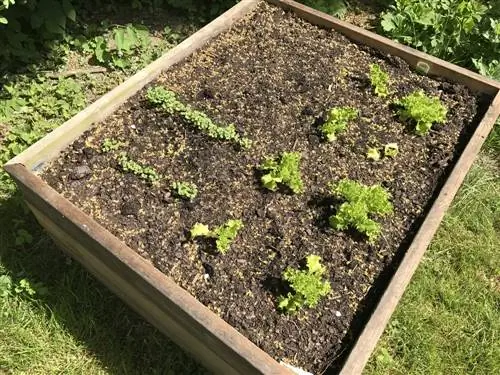- Author admin [email protected].
- Public 2023-12-16 16:46.
- Last modified 2025-01-23 11:21.
A raised bed is perfect for growing lots of vegetables. If you plant many different species and varieties, then not only is variety guaranteed, but you also have fewer problems with pests and diseases. With careful cultivation planning, you can make optimal use of the raised bed area.
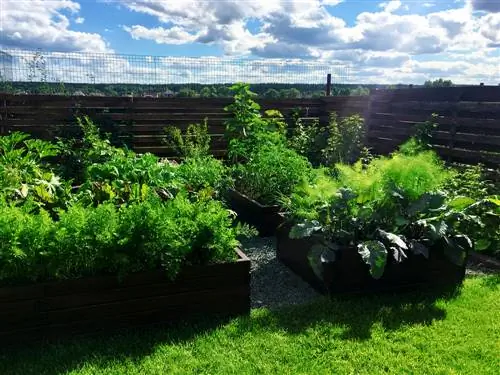
What vegetables can you grow in raised beds?
Numerous types of vegetables such as salads, tubers and root vegetables, legumes, fruit vegetables, leeks and onions as well as cabbages are suitable in raised beds. Growing different varieties creates variety and reduces pest and disease risks.
Salads and other leafy vegetables
Salads can be classified into two groups: head, pick and cut lettuces belong to the lettuce genus. They are primarily sown or planted in early spring through summer. Typical autumn salads, on the other hand, are endive and radicchio, which, like sugar loaf and chicory, are chicory. Salads have medium nutrient requirements and should not be planted on freshly layered raised beds - the high nutrient supply means they produce harmful nitrates. Other worthwhile leafy vegetables that can also be wonderfully steamed or fried are Asian salads such as mizuna or pak choi. Lamb's lettuce, winter lamb's lettuce as well as spinach and chard are uncomplicated, insensitive and can be cultivated at almost any time of the year.
tuber and root vegetables
Most tuber and root vegetables also have medium nutritional requirements. However, they are easy to cultivate and harmonize with many other vegetables. That's why carrots, parsnips, root parsley, radishes, kohlrabi and beetroot belong in every raised bed - you basically can't go wrong with these vegetables. If you like the taste, you can also plant celery, fennel and radish. By the way, celery is a heavy eater and needs a lot of nutrients.
Protein-rich legumes
Pulses have very low nutrient requirements, are easy to cultivate and always produce a rich harvest. Tender sugar snap peas or sweet marshmallow peas are sown from April and go well with kohlrabi, lettuce, radishes, radishes, fennel, carrots, parsnips and root parsley. In contrast to pole or runner beans, bush beans grow lower and are therefore ideal for raised beds. They also don't require as much heat as their looping relatives. Beans are sown directly into the bed between May and July and go excellently with lettuce, strawberries, cabbage, chard, radishes, beetroot and tomatoes.
Tomatoes and other fruit vegetables
Fruit vegetables include tomatoes, peppers, hot peppers, eggplant, cucumbers, zucchini, pumpkin and melons. They all have very high nutrient requirements and therefore feel particularly comfortable on a freshly layered raised bed. However, these plants grow very large - and therefore need both space and often a climbing aid - and are also very sensitive. Fruit vegetables love sun and warmth, and a location protected from rain and drafts also makes sense. You should never sow these vegetables directly, but only plant early plants in the bed.
Leek and onion family
Onions, shallots, garlic and leeks are indispensable in every kitchen - so they should definitely not be missing from the raised vegetable bed. You can sow onions directly into the bed, but they are easier to cultivate using onion sets. Garlic is best planted in raised beds in October or February/March. The toes must be about five centimeters deep in the ground. Leeks are available in different summer and winter varieties that can be cultivated all year round.
cabbage
Almost all types and varieties of cabbage have high nutrient requirements. Both white and red cabbage, kale as well as broccoli (head and sprout broccoli), cauliflower and Romanesco can be cultivated wonderfully in the raised bed. Here, too, there are different varieties, each of which is particularly suitable for cultivation in spring, summer or autumn. Varieties planted at the wrong time of year tend to bolt quickly.
Tip
In particular, culinary herbs such as parsley, chives, etc. can be easily grown together with other vegetables in raised beds. Mediterranean herbs, on the other hand, grow better in their own bed, as their requirements in terms of soil and care differ greatly from other vegetables.

